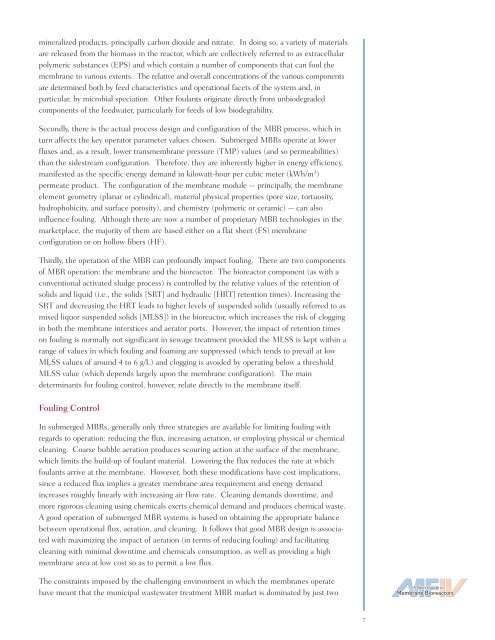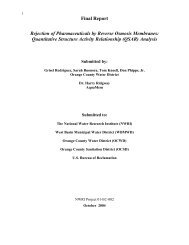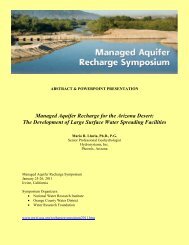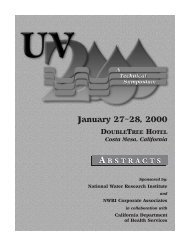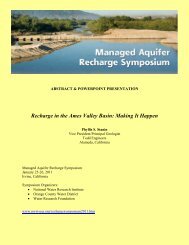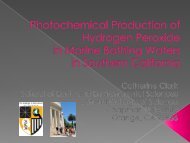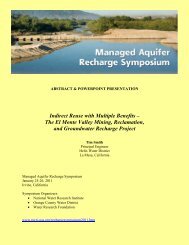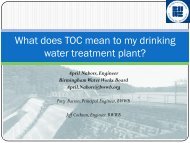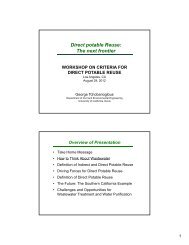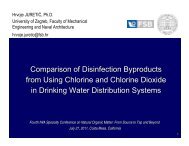Membrane Bioreactors Short Course Abstracts - National Water ...
Membrane Bioreactors Short Course Abstracts - National Water ...
Membrane Bioreactors Short Course Abstracts - National Water ...
You also want an ePaper? Increase the reach of your titles
YUMPU automatically turns print PDFs into web optimized ePapers that Google loves.
mineralized products, principally carbon dioxide and nitrate. In doing so, a variety of materials<br />
are released from the biomass in the reactor, which are collectively referred to as extracellular<br />
polymeric substances (EPS) and which contain a number of components that can foul the<br />
membrane to various extents. The relative and overall concentrations of the various components<br />
are determined both by feed characteristics and operational facets of the system and, in<br />
particular, by microbial speciation. Other foulants originate directly from unbiodegraded<br />
components of the feedwater, particularly for feeds of low biodegrability.<br />
Secondly, there is the actual process design and configuration of the MBR process, which in<br />
turn affects the key operator parameter values chosen. Submerged MBRs operate at lower<br />
fluxes and, as a result, lower transmembrane pressure (TMP) values (and so permeabilities)<br />
than the sidestream configuration. Therefore, they are inherently higher in energy efficiency,<br />
manifested as the specific energy demand in kilowatt-hour per cubic meter (kWh/m 3 )<br />
permeate product. The configuration of the membrane module — principally, the membrane<br />
element geometry (planar or cylindrical), material physical properties (pore size, tortuosity,<br />
hydrophobicity, and surface porosity), and chemistry (polymeric or ceramic) — can also<br />
influence fouling. Although there are now a number of proprietary MBR technologies in the<br />
marketplace, the majority of them are based either on a flat sheet (FS) membrane<br />
configuration or on hollow fibers (HF).<br />
Thirdly, the operation of the MBR can profoundly impact fouling. There are two components<br />
of MBR operation: the membrane and the bioreactor. The bioreactor component (as with a<br />
conventional activated sludge process) is controlled by the relative values of the retention of<br />
solids and liquid (i.e., the solids [SRT] and hydraulic [HRT] retention times). Increasing the<br />
SRT and decreasing the HRT leads to higher levels of suspended solids (usually referred to as<br />
mixed liquor suspended solids [MLSS]) in the bioreactor, which increases the risk of clogging<br />
in both the membrane interstices and aerator ports. However, the impact of retention times<br />
on fouling is normally not significant in sewage treatment provided the MLSS is kept within a<br />
range of values in which fouling and foaming are suppressed (which tends to prevail at low<br />
MLSS values of around 4 to 6 g/L) and clogging is avoided by operating below a threshold<br />
MLSS value (which depends largely upon the membrane configuration). The main<br />
determinants for fouling control, however, relate directly to the membrane itself.<br />
Fouling Control<br />
In submerged MBRs, generally only three strategies are available for limiting fouling with<br />
regards to operation: reducing the flux, increasing aeration, or employing physical or chemical<br />
cleaning. Coarse bubble aeration produces scouring action at the surface of the membrane,<br />
which limits the build-up of foulant material. Lowering the flux reduces the rate at which<br />
foulants arrive at the membrane. However, both these modifications have cost implications,<br />
since a reduced flux implies a greater membrane area requirement and energy demand<br />
increases roughly linearly with increasing air flow rate. Cleaning demands downtime, and<br />
more rigorous cleaning using chemicals exerts chemical demand and produces chemical waste.<br />
A good operation of submerged MBR systems is based on obtaining the appropriate balance<br />
between operational flux, aeration, and cleaning. It follows that good MBR design is associated<br />
with maximizing the impact of aeration (in terms of reducing fouling) and facilitating<br />
cleaning with minimal downtime and chemicals consumption, as well as providing a high<br />
membrane area at low cost so as to permit a low flux.<br />
The constraints imposed by the challenging environment in which the membranes operate<br />
have meant that the municipal wastewater treatment MBR market is dominated by just two<br />
A <strong>Short</strong> <strong>Course</strong> on<br />
<strong>Membrane</strong> <strong>Bioreactors</strong><br />
7


